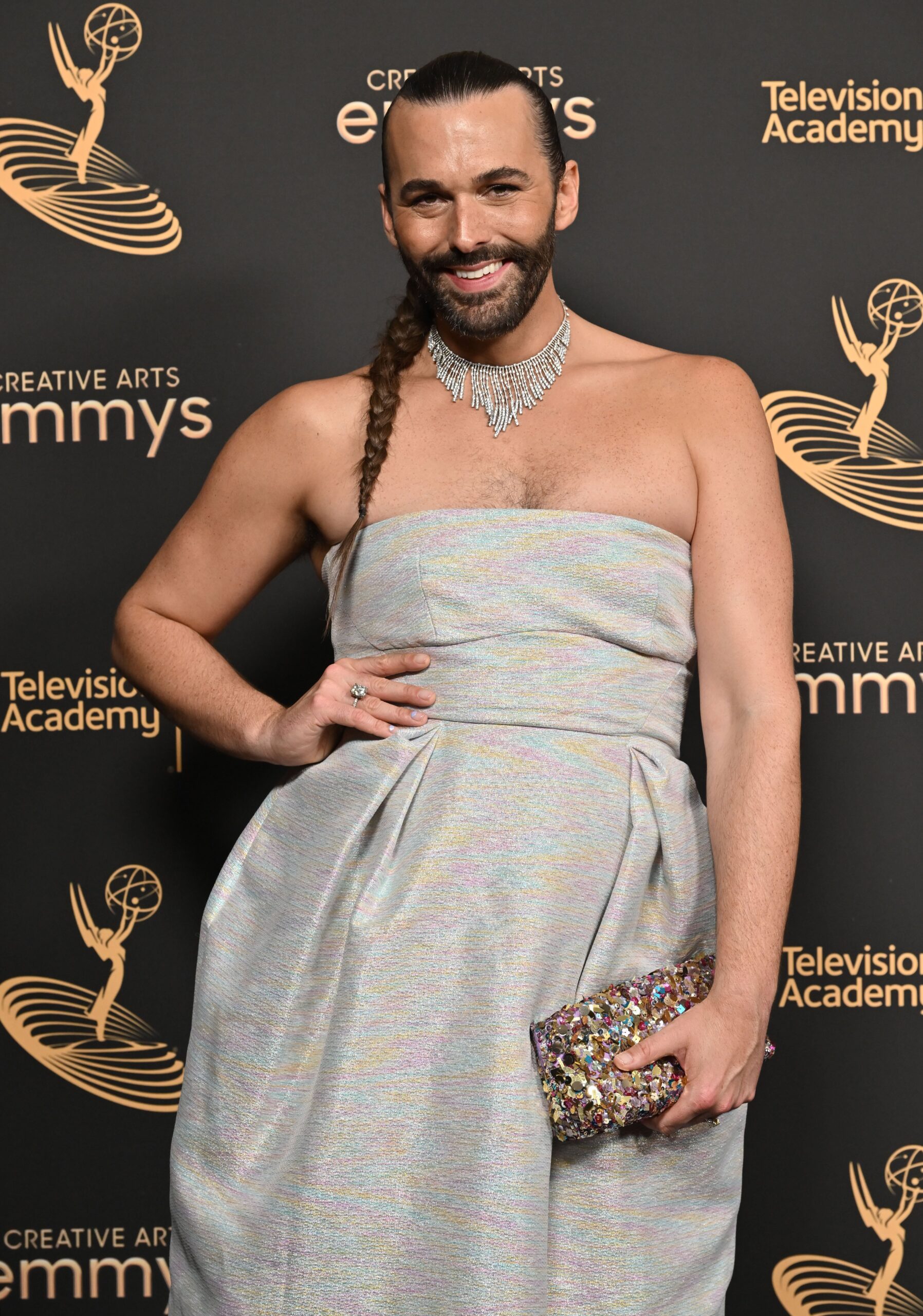Popular
How Jonathan Van Ness Can Save Us All: The History of HIV Representation in Media
25 Sep, 19

Jonathan Van Ness
Photo by By Rob Latour (Shutterstock)
Our beloved Gay Jesus, Jonathan Van Ness, may actually save lives in coming years.
No, perhaps not directly, but as a darling of Netflix’s Emmy-nominated Queer Eye, Van Ness has a platform to represent the LGBTQ+ community and be the voice of social change that’s heard with a simple streaming subscription; and in a candid interview with The New York Times, Van Ness recently shared that he’s living with HIV. Ahead of the release of his memoir, Over the Top: A Raw Journey to Self-Love, the non-binary TV personality shared his story of testing positive at 25 after fainting one day at work. “When Queer Eye came out, it was really difficult because I was like, ‘Do I want to talk about my status?'” he said. “And then I was like, ‘The Trump administration has done everything they can do to have the stigmatization of the L.G.B.T. community thrive around me’…I do feel the need to talk about this.” Now 32, he’s opening up about being an addict and a survivor of sexual abuse long before he became Queer Eye‘s “effervescent, gregarious majestic center-part-blow-dry cotton-candy figure-skating queen,” in his own words.
Van Ness might be the ideal icon to openly speak about the reality of living with HIV/AIDS in 2019. He’s called the success of Queer Eye “the honor of a lifetime,” and he’s become a public face for non-binary members of the LGBTQ+ community (along with singer Sam Smith and actors like Asia Kate Dillon and Nico Tortorella).
But while queer representation in TV and film is still hardly substantial, when it comes to HIV status, media representation is about more than just fairness and accuracy. When the HIV/AIDS epidemic disrupted the public’s sense of safety in the 1980s, deep misunderstandings and fear of the unknown fostered intense stigma against HIV-positive individuals. In the decades since, studies and public polling have shown that increased media representation of HIV/AIDS directly correlates with reduced social stigma. About six in ten Americans get their HIV/AIDS information from the media, whether that’s watching Tales of the City‘s HIV-positive Michael Tolliver deepen his relationship with his HIV-negative boyfriend or watching Van Ness crown each of his clients “queen.” Van Ness joins a small cohort of celebrities who are open about their HIV-positive status. Former Wales rugby player Gareth Thomas also recently confirmed he was living with HIV. Soon after, UK’s leading HIV and sexual health charity shared that they’d seen a “sharp increase in the number of people accessing information about HIV from our website and THT Direct telephone service,” as well as orders for their HIV self-test kits.
Today, about half of all Americans (52%) are not familiar with the term “undetectable,” and 8% say they’ve heard the term but are unaware of what it means. Simply, HIV-positive individuals treated with antiretroviral therapy (ART) can have viral loads so low that they’re not detected by standard lab tests. Hence, in a treated individual, the virus cannot replicate in the body and the individual cannot pass on the virus to another person: “Undetectable equals untransmittable.” People can reach this stage of the disease within six months of beginning treatment—and continue to live full, uninterrupted lives. Additionally, polls assessing public awareness of new HIV prevention strategies, like pre-exposure prophylaxis (PrEP), find that less than half (42%) of the public is aware of the daily pill or the fact that individuals who are at a high risk of contracting HIV can reduce their risk by as much as 99% (as long as they take it consistently).
“I’ve had nightmares every night for the past three months because I’m scared to be this vulnerable with people,” Van Ness told The New York Times. His fears went beyond his career as a TV personality; there’s still rampant misunderstandings about who becomes infected with HIV which date back to panicked media coverage in the 1980s. In 1985, American movie icon Rock Hudson was the first well-known celebrity to die of AIDS-related complications; rock icon Freddie Mercury confirmed his HIV-positive status the day before his death from the disease in 1991; and fear continued to dominate America. Infected patients were treated as pariahs as paranoia and fear about the virus pervaded society. “Nurses wouldn’t tend to their bedside; they wouldn’t deliver them food,” says Joanne Simons, CEO of Casey House, an HIV/AIDs speciality hospital in Toronto. “They were obviously really concerned about contracting HIV themselves and [there was] really a lack of understanding that it couldn’t be transmitted through touch.”
But celebrity outreach and increased media representation soon began shifting attitudes. In 1991, when Princess Diana visited patients at Casey House, front-page photographs showed her shaking hands with patients and kissing them on the cheeks, inspiring more compassion for infected individuals and, perhaps more importantly, dispelling common myths about the disease that caused stigma to fester. Similarly, in 1991 Magic Johnson announced his retirement from basketball due to his positive HIV diagnosis; and in the ’90s Pedro Zamora became one of the first openly gay men in popular TV, appearing on MTV’s The Real World: San Francisco to educate viewers about living with HIV before passing away from AIDS-related complications shortly afterward. Pop culture slowly began to represent the human side of the disease in films Iike Philadelphia (1993) and And the Band Played On (1993). On ER (1997) Jeanie Boulder was the first TV character to contract HIV (she received treatment and went on to thrive throughout the series, becoming a counselor for youth with HIV).
In fact, a Gallup poll conducted in 1997 found: “The public is somewhat less critical of those who get AIDS than it was a decade ago, but 31% of Americans still believe that AIDS is a punishment for a decline in moral standards (compared with 43% who felt that way ten years ago), and 40% say that the victims of AIDS are themselves to blame for getting the disease (compared with 51% who felt that way in 1987).”
HIV-positive characters have been slowly working their way into TV shows, from the aughts’ Queer as Folk to the more recent Tales of the City, Pose, How to Get Away With Murder, Looking, and even Sesame Street.Characters grapple with their new diagnosis, process the loss of friends, navigate serodiscordent relationships (one between an HIV-positive and negative individual), and generally get on with their lives without HIV defining their characters. Thanks to increased visibility and public health awareness, recent polls find that most Americans of all racial and ethnic backgrounds are “comfortable working with (79%), having a close friendship with (77%), and sharing a living space with (62%) someone who is living with HIV. This is true across racial and ethnic lines.”
But none of that is to say there’s enough media representation or understanding in society; that’s partly what was giving Jonathan Van Ness nightmares in the weeks before sharing his HIV status. With a large majority of Americans (80%) identifying HIV as a “serious national issue,” and with 46% reporting to personally know someone for whom it is a “serious concern,” living with HIV is not a marginalized experience. To date, about 1.1 million people in the U.S. are HIV-positive (with an estimated 1 in 7 unaware of their infection). While we reject stigmas that attach moral judgments to HIV status, it’s often underestimated how infection rates affect all sexual orientations, ethnicities, and socioeconomic statuses. For instance, most newly infected individuals are between the ages of 25-34, and gay and bisexual men only account for an estimated 66% of annual HIV diagnoses through sexual contact, leaving heterosexuals to account for 24%. The numbers, though, reveal more nuance and social disparity when evaluated for rates of infection in underserved communities and for people of color.
In 2019, there’s no reason for media’s scant representation of mixed HIV status relationships or accurate depictions of living with HIV—other than stigma, which lingers as the backfire of ignorance. Interestingly, in 2017 The Elizabeth Taylor AIDs Foundation (ETAF) noticed a particular absence of HIV-positive characters in American TV. ETAF Ambassador and actor Daniel Franzese (Looking, Mean Girls) and ETAF Managing Director Joel Goldman held a roundtable discussion with actors and network show creators from HBO and NBC to discuss “how the current lack of HIV representation is related to the climbing infection rates today.” The roundtable concluded, “The lack of HIV stories may have a correlation with the rise in infection rates and the fact that people are either choosing not to or don’t know how to be treated once they’re diagnosed.” Franzese (who has credited his Mean Girls role as the lead character’s gay best friend for helping hm to come out as gay) says that the LGBTQ+ community has “moved on to adoption and marriage equality and trans acceptance, but it seems that HIV has taken a backseat to those other movements and they are all important, but I feel like we need as a community to bring that issue back to the forefront.”
He added that pop culture icons—exactly the likes of Jonathan Van Ness—are key to spreading education and prevention to fans of all ages and backgrounds. “Let’s see Beyonce take a PrEP pill with a glass of lemonade,” he said.
- Getting Curious with Jonathan Van Ness on Apple Podcasts ›
- Jonathan Van Ness (@jvn) | Twitter ›
- Jonathan Van Ness: George H.W. Bush’s ‘Inaction Allowed AIDS to … ›
- Queer Eye’s Jonathan Van Ness reveals he’s HIV positive | London … ›
- Queer Eye’s Jonathan Van Ness comes out as HIV-positive – Metro … ›
- Queer Eye’s Jonathan Van Ness opens up about his battle with … ›
- Queer Eye’s Jonathan Van Ness Is Waiting for the Salon World’s … ›
- Quick Talk With Jonathan Van Ness | Time ›
- Jonathan Van Ness Reminds People Of George H.W. Bush’s AIDS … ›













